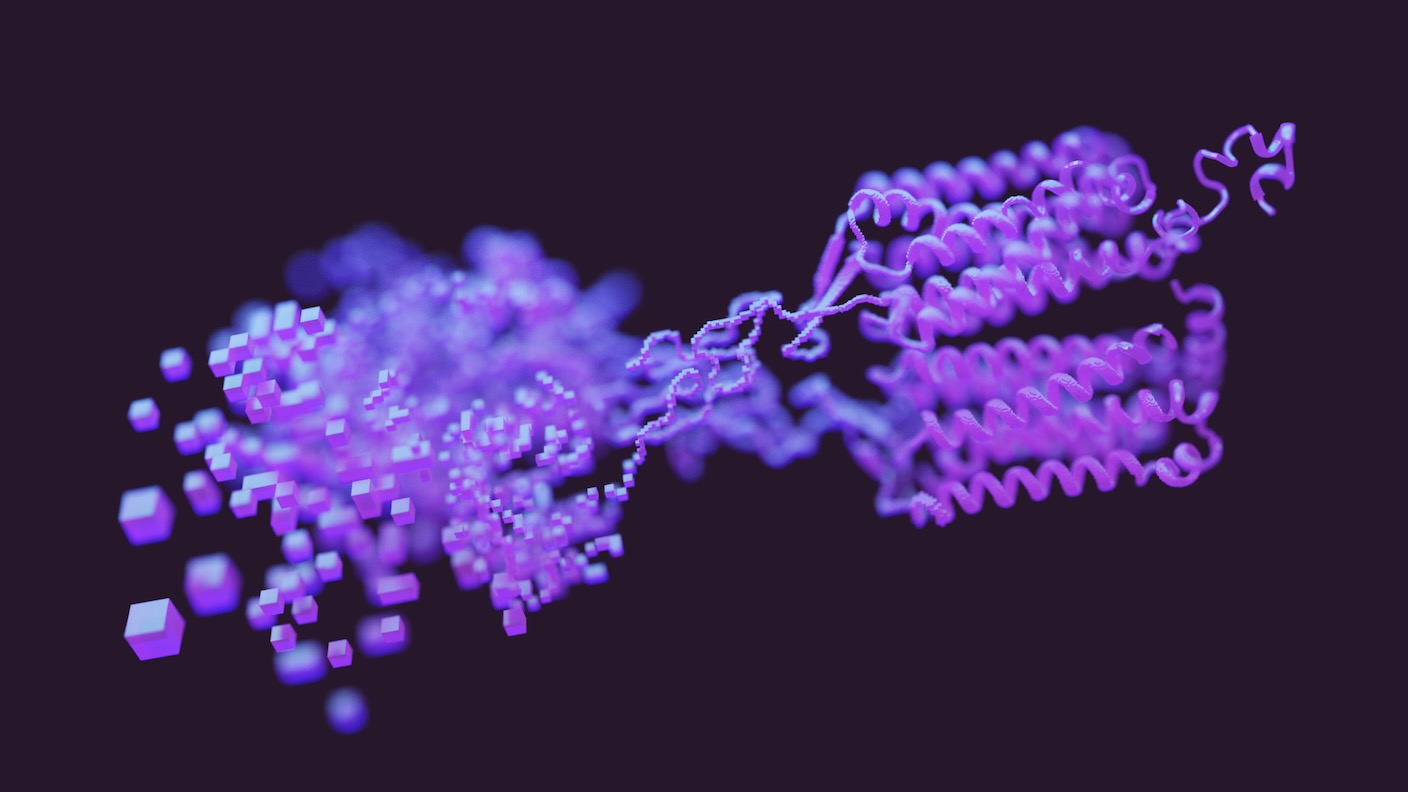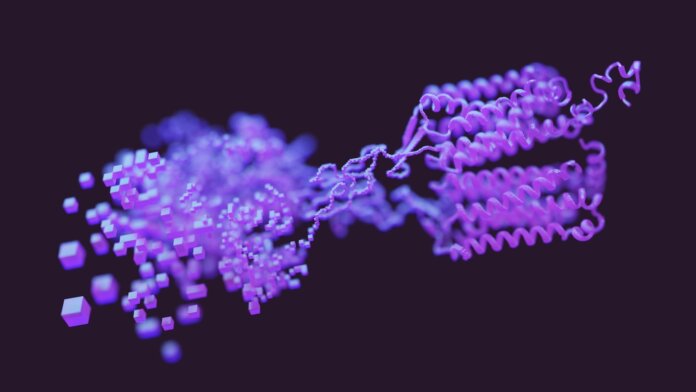
This AI Can Design the Machinery of Life With Atomic Precision
The new AI will be offered publicly to scientists so they can create novel interacting bio-components that could lead to new therapies.
This AI Can Design the Machinery of Life With Atomic Precision
By Shelly FanMarch 8, 2024

Proteins are social creatures. They’re also chameleons. Depending on a cell’s needs, they rapidly transform in structure and grab onto other biomolecules in an intricate dance.
It’s not molecular dinner theater. Rather, these partnerships are the heart of biological processes. Some turn genes on or off. Others nudge aging “zombie” cells to self-destruct or keep our cognition and memory in tip-top shape by reshaping brain networks.
These connections have already inspired a wide range of therapies—and new therapies could be accelerated by AI that can model and design biomolecules. But previous AI tools solely focused on proteins and their interactions, casting their non-protein partners aside.
This week, a study in Science expanded AI’s ability to model a wide variety of other biomolecules that physically grab onto proteins, including the iron-containing small molecules that form the center of oxygen carriers.
Led by Dr. David Baker at the University of Washington, the new AI broadens the scope of biomolecular design. Dubbed RoseTTAFold All-Atom, it builds upon a previous protein-only system to incorporate a myriad of other biomolecules, such as DNA and RNA. It also adds small molecules—for example, iron—that are integral to certain protein functions.
The AI learned only from the sequence and structure of the components—without any idea of their 3D structure—but can map out complex molecular machines at the atomic level.
In the study, when paired with generative AI, RoseTTAFold All-Atom created proteins that easily grabbed onto a heart disease medication. The algorithm also generated proteins that regulate heme, an iron-rich molecule that helps blood carry oxygen, and bilin, a chemical in plants and bacteria that absorbs light for their metabolism.
These examples are just proofs of concept. The team is releasing RoseTTAFold All-Atom to the public for scientists so they can create multiple interacting bio-components with far more complexity than protein complexes alone. In turn, the creations could lead to new therapies.
“Our goal here was to build an AI tool that could generate more sophisticated therapies and other useful molecules,” said study author Woody Ahern in a press release.
Dream On
In 2020, Google DeepMind’s AlphaFold and Baker Lab’s RoseTTAFold solved the protein structure prediction problem that had baffled scientists for half a century and ushered in a new era of protein research. Updated versions of these algorithms mapped all protein structures both known and unknown to science.Next, generative AI—the technology behind OpenAI’s ChatGPT and Google’s Gemini—sparked a creative frenzy of designer proteins with an impressive range of activity. Some newly generated proteins regulated a hormone that kept calcium levels in check. Others led to artificial enzymes or proteins that could readily change their shape like transistors in electronic circuits.
By hallucinating a new world of protein structures, generative AI has the potential to dream up a generation of synthetic proteins to regulate our biology and health.
But there’s a problem. Designer protein AI models have tunnel vision: They are too focused on proteins.
When envisioning life’s molecular components, proteins, DNA, and fatty acids come to mind. But inside a cell, these structures are often held together by small molecules that mesh with surrounding components, together forming a functional bio-assembly.
One example is heme, a ring-like molecule that incorporates iron. Heme is the basis of hemoglobin in red blood cells, which shuttles oxygen throughout the body and grabs onto surrounding protein “hooks” using a variety of chemical bonds.
Unlike proteins or DNA, which can be modeled as a string of molecular “letters,” small molecules and their interactions are hard to capture. But they’re critical to biology’s complex molecular machines and can dramatically alter their functions.
Which is why, in their new study, the researchers aimed to broaden AI’s scope beyond proteins.
“We set out to develop a structure prediction method capable of generating 3D coordinates for all atoms” for a biological molecule, including proteins, DNA, and other modifications, the authors wrote in their paper.
Tag Team
The team began by modifying a previous protein modeling AI to incorporate other molecules.The AI works on three levels: The first analyzes a protein’s one-dimensional “letter” sequence, like words on a page. Next, a 2D map tracks how far each protein “word” is from another. Finally, 3D coordinates—a bit like GPS—map the overall structure of the protein.
Then comes the upgrade. To incorporate small molecule information into the model, the team added data about atomic sites and chemical connections into the first two layers.
In the third, they focused on chirality—that is, if a chemical’s structure is left or right-handed. Like our hands, chemicals can also have mirrored structures with vastly differing biological consequences. Like putting on gloves, only the correct “handedness” of a chemical can fit a given bio-assembly “glove.”
RoseTTAFold All-Atom was then trained on multiple datasets with hundreds of thousands of datapoints describing proteins, small molecules, and their interactions. Eventually, it learned general properties of small molecules useful for building plausible protein assemblies. As a sanity check, the team also added a “confidence gauge” to identify high-quality predictions—those that lead to stable and functional bio-assemblies.
Unlike previous protein-only AI models, RoseTTAFold All-Atom “can model full biomolecular systems,” wrote the team.
In a series of tests, the upgraded model outperformed previous methods when learning to “dock” small molecules onto a given protein—a key component of drug discovery—by rapidly predicting interactions between proteins and non-protein molecules.
Brave New World
Incorporating small molecules opens a whole new level of custom protein design.As a proof of concept, the team meshed RoseTTAFold All-Atom with a generative AI model they had previously developed and designed protein partners for three different small molecules.
The first was digoxigenin, which is used to treat heart diseases but can have side effects. A protein that grabs onto it reduces toxicity. Even without prior knowledge of the molecule, the AI designed several protein binders that tempered digoxigenin levels when tested in cultured cells.
The AI also designed proteins that bind to heme, a small molecule critical for oxygen transfer in red blood cells, and bilin, which helps a variety of creatures absorb light.
Unlike previous methods, the team explained, the AI can “readily generate novel proteins” that grab onto small molecules without any expert knowledge.
It can also make highly accurate predictions about the strength of connections between proteins and small molecules at the atomic level, making it possible to rationally build a whole new universe of complex biomolecular structures.
“By empowering scientists everywhere to generate biomolecules with unprecedented precision, we’re opening the door to groundbreaking discoveries and practical applications that will shape the future of medicine, materials science, and beyond,” said Baker.
Image Credit: Ian C. Haydon